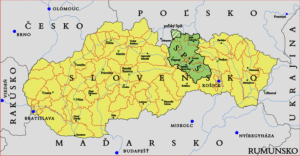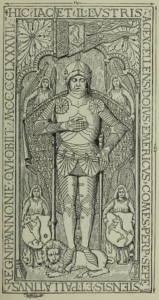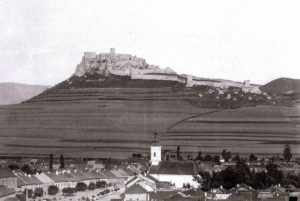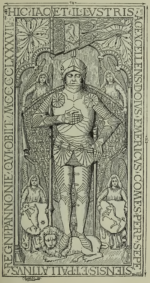Szepesi vár

Szepesi vár also known as Szepesvár Castle (Spissky Hrad, Zipser Burg) is located in Slovakia. It is situated on the top of a 200-meter-high cliff overlooking the Szepes Basin. It is one of the largest castles in Europe with an area of 4 hectares. As it was the eagle’s nest of the Szapolyai family, its history is closely connected with the last Hungarian native king, Szapolyai János. (Please note that I use the oriental name order for Hungarians, where the surname comes first).

The cliff was inhabited as early as the 5th millennium B.C., and yes, the Celts built the first huge fortress there between the 1st and 2nd centuries B.C. The buildings built by the Celts were connected by paved stone roads. When this ancient castle was destroyed, the next one was built on the neighboring hill called Drevenyik. However, after the Drevenyik castle was washed away by the waves of history, the core of today’s Szepes Castle was built on the original site where we can see it today.

The Magyar (Hungarian) tribes arrived in the 9th century A.D. They settled in this region, but it remained a sparsely populated area. The first Hungarian settlers gave this land the name “Szép” (“beautiful”). It was King Géza II who invited German guests here in the 1150s. The new settlers began to use the name “Szép”, and thus the area is called “Zipszer” — Spis — Zips (Hungarian: Szepes). You can read more about this region called “Szepesség”, the northern jewel of the Hungarian Kingdom here:
https://www.hungarianottomanwars.com/essays/szepesseg/

Szepes Castle became the political, administrative, economic and cultural center of Szepes County of the Kingdom of Hungary. The German settlers turned the Szepesség region into a rich and flourishing land under the Carpathian Mountains. They did not only work in the fields, but also built towns and the German craftsmen were famous all over Hungary. The German citizens were also very good traders and improved the trade between Hungary, Poland and Bohemia. We should also mention the mines that the Carpathian Germans started: they produced enormous amounts of silver and gold, not to mention other kinds of ores. Here is more about the money of the Kingdom of Hungary:
https://www.hungarianottomanwars.com/essays/the-mining-towns-of-upper-hungary/

As a rule, the Hungarian kings owned most of the castles during the Árpád dynasty, until 1300. It is not surprising that the king was the first builder of Szepes Castle: the oldest part of the medieval castle was built in the second half of the 12th century on the site of an earlier structure. A round stone tower with a diameter of 22 meters was built in the middle of the hilltop, with a cistern carved into the rock. This early castle was also surrounded by a stone wall. The place became the seat of the Comes of Szepes County.

Szepes Castle has been rebuilt and reconstructed in the last 1000 years, but it is basically a castle with an irregular ground plan and an inner tower. It remained an old-fashioned fortification even after the development of cannons, because it was far from the Hungarian-Ottoman military border. The castle can be divided into three parts, which stood on higher ground: the lower castle, the middle castle and the citadel. Here is a video of what it might have looked like in the 17th century:
https://www.youtube.com/watch?v=1r5ujjEIjDk

The first fort was destroyed by an earthquake before the Mongol Invasion of 1241-42 and had to be rebuilt. Perhaps this was the reason why the guards were so successful in defending it against the invading Mongols. Only a dozen stone castles in Hungary could resist them. After the Mongol threat was over, we can see the castle intact with its Romanesque stone fortifications, including a two-story Romanesque palace. Soon a three-nave Romanesque-Gothic basilica was built at the end of the 13th century. It is believed that Italian masons came from Lombardy to build the walls.

King Béla IV was called the Second Founder of Hungary: he saw how successfully the stone fortresses resisted the Mongols, so he had many castles built in the Carpathian Basin. The first written mention of Szepes Castle can be found in his document dated September 19, 1249. In this document he donated land to the Bishop of Szepes, where the priest was allowed to build a palace and a stone castle at his own expense. This is how the castle was enlarged. The area of the castle was doubled.

In fact, the bishop had the outer castle courtyard built, along with a gate protected by a tower. It was he who built the stone wall of the outer castle. However, the bishop moved his residence to the Szepes chapter before the end of the 13th century.

There was an important battle in the castle of Szepes in 1275, when the castle’ Comes, called Roland, rebelled against the king. After he was defeated, the castle became the property of Kun Erzsébet, the mother of King (Kun) László IV. Since Szepes Castle controlled an important region, it was the target of many battles in the 14th century. The castle was held by the followers of King (Cseh) Vencel, who reigned between 1301 and 1305. Then the men of the new king, the Anjou Károly Róbert took it from them in 1304. However, the Bohemians returned for a short time in 1307. King Károly Róbert needed some time to defeat the rebellious oligarchs of the kingdom. One of them was the powerful lord Csák Máté, who attacked the castle of Szepes in 1312, but the king’s soldiers repelled his attack.

The castle was further fortified in the second half of the 14th century, during the reign of King Lajos I. A new castle courtyard was built, which is now the “middle courtyard”, a 150-meter long and 60-meter wide square. The castle was completely rebuilt in the 15th century, the walls were raised and a third settlement was built.

Since Szepes Castle was such an important castle in the kingdom, the Hungarian monarchs often gave it to their most trusted noblemen and barons. This meant that the barons received a huge income from the properties belonging to Szepes Castle, and they enjoyed this money only for the time they held high positions at the court.

King Zsigmond of Luxembourg needed money to defend Hungary against the Ottomans, so he pledged the Szepesség region to Poland in 1412. It included 16 settlements, and Szepesváralja, the town below Szepes Castle, was one of them. The king deliberately kept Szepes Castle in his hands and in 1439 he gave it to Rozgonyi István in exchange for his military deeds. After the death of the king, Rozgonyi lost the castle to the army of the Bohemian Hussite leader Jan Jiskra.

It was the Hungarian Queen Erzsébet who called the Hussite mercenaries to Hungary to support her son’s claim to the throne. The Hussites conquered large areas of Northern Hungary, where they plundered villages and towns. The men of Jiskra built a round tower in the middle of the castle after 1445. It was also surrounded by a wooden palisade and a dry moat. The Hussite war wagons were placed around the walls to protect their leader. Later, the lower castle was also built: its function was to provide a better place for the fearsome Hussite war wagons.

Jan Jiskra sold the castle of Szepes in 1454 to Thurzó György, a citizen of Lőcse. It is said that Thurzó paid 2,130 gold pieces for the castle, but within a few years the castle returned to the Jiskra family. We do not know the details of the deal. Finally, it was the treasurer of King Matthias Corvinus who took back Szepes Castle in 1462. His name was Szapolyai Imre.

In 1464 the king gave him the castle of Szepes, which belonged to the Szapolyai family until 1528. It was their headquarters from where they controlled their 70 castles. No wonder they were called the Counts of Szepes. They made further improvements to the castle: they built the western line of palaces after 1465. They also built a late Gothic chapel in 1470, dedicated to Saint Erzsébet. The Szapolyai family transformed the upper castle into a comfortable family residence, typical of the Renaissance residences of the 16th century. Palatine Szapolyai István must have felt like a king: his son was given a royal education. He was Szapolyai János, the last native Hungarian king, who was born in the castle in 1487. Legend has it that when King Matthias Corvinus saw the newborn, he prophesied that he would be the next king of Hungary.

Szapolyai István was at the deathbed of King Matthias Corvinus, as was Queen Beatrix, and rumor has it that they were involved in the poisoning of the king in 1490. According to a contemporary story, Szapolyai István picked up his 3-year-old son János immediately after the king’s death and said to him: “If you were older, I would make you king!”

When he grew up, Szapolyai János became the voivode of Transylvania and the leader of the anti-Habsburg nobles of the kingdom. When King Lajos II died in the Battle of Mohács in 1526, Szapolyai was accused of not rushing quickly enough with the Transylvanian army to his aid. However, historians proved that he could not have arrived in time, and he even left his troops behind and hurried to Mohács just to be there. Well, he was late, but his younger brother György fought and died in the battle.

Szerémi György (1490-1548) was the court chaplain of King Lajos II, later he served King Szapolyai János. When King Szapolyai János died in 1540, Szerémi wrote his chronicle because he was free to tell the truth after his master’s death. According to his work, the Epistola de perdicione Regni Hungarorum, King Lajos II didn’t die in the swamp at all: it was Szapolyai György who killed him with a Czech dagger.

The young king was carried away from the battlefield by his generals, Tomori and Szapolyai, and they rested in Dunaszekcső, in the house of the local priest. The king took off his armor and cleaned himself in a barrel. Tomori Pál left the room and went out to control his men. Then Szapolyai György was alone with the king who was only wearing a shirt. Szerémi says: “György shouted: “You, beastly, dancing king, you have lost Hungary, and you have also denied us the right that we claimed for the property of Prince Lőrinc, yes, you will die now,” then he attacked him with his Czech dagger and stabbed him more than three times. The king fell to the ground…” When Tomori returned, he slaughtered Szapolyai György. In the end, Tomori was also killed by Szapolyai’s men. However, modern historians say that the whole thing was just a fantasy of the chronicler.

We know the next one: after the battle of Mohács, Szapolyai János didn’t go to Buda with his army, so Sultan Suleiman could take it without a fight. When Suleiman left the country, Szapolyai was crowned King of Hungary and was accepted by almost everyone. But soon the Habsburg Ferdinand appeared and usurped his throne, and the Dual Kingship tore the kingdom in two.

The Habsburg army took the castle of Szepes from Szapolyai János’ men with a two-week siege in 1528. Ferdinand gave the castle to the Thurzó family (relatives of the Fugger family) in 1531. Lord Thurzó Elek improved the castle in the Renaissance style, especially the interiors of the buildings were reconstructed. King Szapolyai is a divisive figure in our history, many historians dislike him because he allied with Sultan Suleiman, but others think that it was the only way to save Hungary from the imminent overrun by the Ottomans. It was also he and his son who paved the way for the creation of the Principality of Transylvania.

King Szapolyai János died in 1540, leaving a male heir, János Zsigmond. The soldiers of the late Szapolyai János tried to retake Szepes Castle with a night attack in 1543, but they were repulsed. As Szepes Castle was far from the borderland, it was never updated to meet the artillery challenges of the 16th century. It remained an administrative and economic center of its feudal lord.

The region saw more military actions during the campaigns of the Transylvanian princes in the 17th century. The Hajdú soldiers of Prince Bocskai István tried to take Szepes in 1604, but they were unsuccessful. When the Thurzó family died out, the Csáky family took over the castle by force in 1636. They were the hereditary lords of Szepes county at that time. Prince Rákóczi György I of Transylvania besieged the castle in 1644, but no matter how outdated the fortifications were, they could not take it.

In 1660, the Csáky family built a remarkable row of stone pillars in front of the entrance, with a wooden palisade between them. They also connected the palaces with covered corridors. At that time there were 135 halls and rooms in the castle. The members of the Csáky family lived in the castle until the end of the 17th century, trying to make it a more comfortable place, but they were unsuccessful. Gradually the family members left the castle and built their more comfortable mansions in the neighboring villages.

During the reign of Prince Thököly Imre (1682-1685), the Hungarian Kuruc rebels revolted against the Habsburg oppression and took Kassa (Kaschau, Kosice) and Eperjes (Presov). They also occupied the castle of Szepes. However, the Imperial Army soon regained control over Upper Hungary. To prevent similar uprisings, the military council in Vienna decided in 1702 to destroy many Hungarian castles, including Szepes Castle. Fortunately, the War of Independence broke out in 1703, led by Prince Rákóczi Ferenc II, and Szepes Castle escaped destruction.

The garrison of Szepes Castle didn’t want to surrender to the Kuruc troops. But among them was a tailor named Trencsényi Mátyás, who sided with the Hungarian Kuruc rebels, and he mortally wounded the captain of Szepes Castle. As a result, the garrison surrendered the castle in exchange for safe conduct.

Szepes Castle was not a strategically important place during the War of Independence, but it was the place where Prince Rákóczi had one of his men, General Forgách Simon, imprisoned for treason. The rebels captured Count Maximilian Strahmberg, a high-ranking imperial officer, who was also imprisoned in Szepes, but he was allowed to walk freely in the fortress because he gave his word. However, he broke his promise and escaped from Szepes by using the outer hole of a latrine, which he climbed down one night with a rope. What an escape it would have been.

The last member of the Csáky family left the castle in 1707. Szepes Castle was in the hands of the Kuruc rebels until June 1710, when Görgey János, the vice-magistrate of Szepes County, surrendered the fortress to the besieging imperial troops. Somehow the castle escaped destruction and was not blown up like many Hungarian castles after 1711. Only a small garrison remained.

Unfortunately, in 1780 some of the soldiers got very drunk and tried to make gin in one of the halls. They caused a huge fire and the whole castle burned down. After the disaster the owner didn’t want to rebuild the ruins and the castle was abandoned. The Csáky family owned the ruins of the castle until 1948.

Archaeological excavations and renovations began in the 1980s, and there is still much work to be done. This beautiful castle is now under the protection of UNESCO. The following movies were shot in Szepes Castle:
Dragonheart (1996); Kull, the Conqueror (1997); The Lion In Winter (2003); The Last Legion (2006)

Dear Readers, I can only make this content available through small donations or by selling my books or T-shirts.
If you like my writings, please feel free to support me with a coffee here:
You can check out my books on Amazon or Draft2Digital, they are available in hardcover, paperback, or ebook:
https://www.amazon.com/dp/198020490X
or at https://books2read.com/b/boYd81


My work can also be followed and supported on Patreon:

Here are more pictures of Szepes castle:































